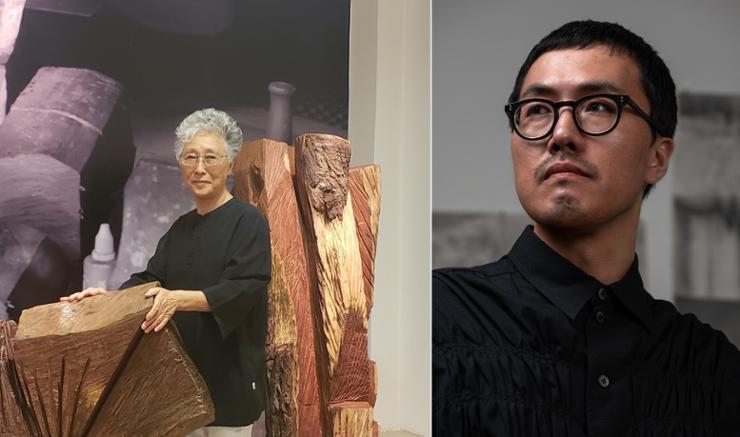Artists Kim Yun-shin, left, and Lee Kang-seung / Courtesy of Kukje Gallery, Lehmann Maupin and the artists
ARKO, high-end galleries announce special Korean exhibitions coinciding with Biennale
By Park Han-sol
The Venice Biennale, the world’s longest-running and most prestigious survey of contemporary art, is set to return to Italy’s floating city on April 20 for its 60th edition.
Under the theme of “Foreigners Everywhere,” the newly announced roster of 332 artists participating in its flagship International Art Exhibition, curated by Adriano Pedrosa, includes four creatives who come from Korea — two living and two historical.
Among the selected artists is the octogenarian sculptor Kim Yun-shin, who has been gaining attention in the local art scene after her inaugural retrospective at the Nam-Seoul Museum of Art in 2023.
Considered “missing” from her home country’s art world for decades, Kim relocated to Argentina in 1984 in pursuit of the ideal creative material. Over her six-decade journey, she has crafted an organic visual language through the labor-intensive shaping of hardwood and stone, most notably in her signature series, “Add Two Add One, Divide Two Divide One.”
Another contemporary talent heading to the Biennale is Seoul-born artist Lee Kang-seung, based in Los Angeles.
Lee’s creative interventions, in the form of photorealistic graphite drawings, gold-threaded embroidery, archival installations and collaborative performances, connect the overlooked legacies left behind by figures of modern LGBTQ+ history and AIDS activism around the world. By doing so, he creates a new type of queer-centric genealogy that transcends national borders and generations.
He is one of the four finalists for the 2023 Korea Artist Prize, a major contemporary art award co-organized by the National Museum of Modern and Contemporary Art, Korea (MMCA).
Choung Byoung-gug, chairperson of the Arts Council Korea, far left, speaks during a joint press conference held on Wednesday at Artist House in central Seoul to announce the seven satellite Korean art exhibitions that will coincide with the 60th edition of the Venice Biennale. Yonhap
The works of two late painters born during the early Japanese colonial rule of Korea — Lee Qoe-de (1913-65) and Chang Woo-soung (1912-2005) — will also be featured in the principal exhibition at the Biennale.
The show focuses on “artists who are themselves foreigners, immigrants, expatriates, diasporic, émigrés, exiled, or refugees,” according to its curator Pedrosa, expanding the definition of “foreigner” to include queer, outsider, folk and Indigenous creatives.
As in previous editions, this year’s Venice Biennale consists of the main International Art Exhibition and 90 national pavilion shows organized by their respective home countries.
The Korean Pavilion’s “Odorama Cities,” co-curated by Jacob Fabricius and Lee Seol-hui, will showcase artist Koo Jeong-a’s site-specific pieces with aromas representing different cities on the peninsula, strategically placed throughout the cylindrical building to take visitors on a “Korean scent journey.”
Crowds gather during the opening ceremony of the Korean Pavilion in Venice’s Giardini parkland in 1995. Courtesy of ARKO
7 satellite Korean exhibitions
The city of Venice offers much more than just the two-part flagship events of the Biennale, with hundreds of satellite shows staged concurrently across its palazzos and alleyways, including 30 “collateral events” officially approved by the Biennale Foundation.
This year, seven of these exhibitions will be dedicated to Korean art, showcasing underrepresented modern trailblazers and archives looking back on the evolution of the country’s art scene over the last three decades.
In celebration of the 30th anniversary of the Korean Pavilion’s establishment in Venice’s Giardini parkland in 1995, the Arts Council Korea (ARKO), as the pavilion’s commissioner, will host “Every Island Is a Mountain.”
Taking place at the Palazzo of the Sovereign Military Order of Malta, this archival show commemorates the pavilion’s history by featuring 38 artists who have represented it since its inception — including Lee Bul, Do Ho Suh, Haegue Yang and Kimsooja.
Yoo Young-kuk’s “Work” (1975) / Courtesy of Yoo Youngkuk Art Foundation
Cultural foundations and high-end galleries will present four collateral events.
“A Journey to the Infinite: Yoo Youngkuk” at the Fondazione Querini Stampalia marks the first European showcase of Yoo (1916-2002), the pioneer of Korean abstract modernism acclaimed for distilling the nation’s natural landscape into the basic formal elements of dots, lines, planes and colors.
Through about 100 large-scale oil paintings, copper prints and archival materials, the event highlights the painter’s creative zenith during the 1960s and 1970s.
“Seundja Rhee: Towards the Antipodes” at ArteNova, curated by the former MMCA director Bartomeu Mari, focuses on Rhee (1918-2009), the first-generation female abstract master, while “La Maison de La Lune Brûlée” at the Fondation d’Entreprise Wilmotte introduces Korea’s centuries-old folk ritual of “daljip teugi” (Moon House Burning) through the contemplative charcoal works of Lee Bae.
To reflect on its history and founding spirit, the Gwangju Biennale Foundation will present “Madang: Where We Become Us” at Il Giardino Bianco Art Space, commemorating the 30th anniversary of Asia’s oldest survey of contemporary art. The featured pieces include Nam June Paik’s imposing installation, “Dolmen,” and a nickel silver bowl that once contained rice balls handed out to civilian demonstrators during the 1980 pro-democracy Gwangju Uprising.
Special exhibitions will also spotlight Shin Sung-hy (1948-2009), recognized for his distinctive “nouage” method involving the weaving and knotting of painted strips of flat canvas, as well as the multinational artist collective Nine Dragon Heads’ experimental “Nomadic Party.”
Seundja Rhee’s “Ojak-kio” (1965) / Courtesy of Korean Research Institute of Contemporary Art
